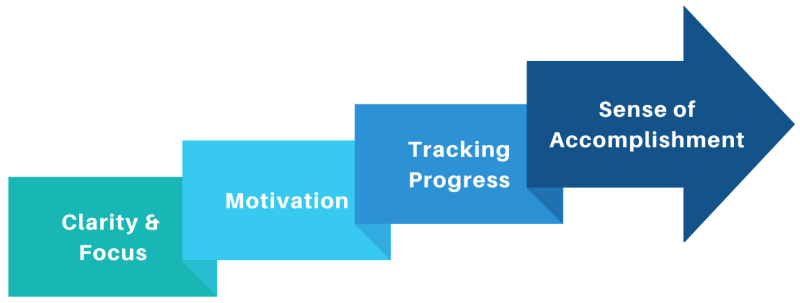One of the key benefits of creating repeatable systems is that they can help us build a clear roadmap for achieving our goals. Systems allow us to break down the steps we need to take to reach our goals, which we can then use to track progress, monitor processes, and stay motivated. Systems also give us a framework to develop a consistent approach to regular tasks and activities, which in turn gives us insights into what we might be able to improve and how. Nothing is completely perfect, and systems will help you continually ‘check and correct’ your course as you work toward your goals.
Systems are also a great way to keep everyone across and accountable for their work in the greater endeavor. This means less of a need for constant monitoring and micromanaging. And when you’ve got a system that reliably produces consistent results, it’s much easier to delegate tasks and trust they’ll be completed to the standards you want. How much will you be able to save in terms of time and resources when this aspect of your business is under control?
The advantages of setting goals
You already know the importance setting goals has in setting your business up for success, but have you written those goals down and articulated them fully to your team? How well do they understand the goals you’re shooting for, and what they mean to the business?
Creating clear, shared goals help your team understand the ‘why’ of what they’re doing so they can focus their efforts, and even play a part in refining processes to get the best outcomes. You can even use shared goals to build a stronger team culture, within and across your business’ different functional areas. Let’s look more closely at some of the benefits of documenting your business goals.

Clarity and focus
When you set a goal, you’re setting clear parameters for what you want to achieve and by when. This ‘line in the sand’ can help you focus your efforts, and prioritize other activities so you don’t get side-tracked.
Motivation
Having goals written down can be a great motivator. They can help you push through challenges, and think more creatively to solve problems – something you’re sure to face when you’re facing a difficult task or a long-term project. Having a goal can give you the drive and determination you need to keep going when the going gets tough.
Tracking progress
Goals also give you a means of tracking your progress. You can see how far you’ve come (which ties in with motivation) and how far you have to go (which ties in with clarity and focus). If you include milestones in your goal pathway, you’ve also got excuses to celebrate your wins along the way (and we’re back to motivation again).
Sense of accomplishment
There’s no better feeling than kicking goals. But you don’t get to enjoy that feeling if you don’t set them. The sense of accomplishment you get, and that your team gets, builds your collective confidence to take on things you may not have felt up to before. It’s a huge bonus for your team’s wellbeing as well as your business’s longer-term success.
Turning your business goals into repeatable systems
Creating systems can seem daunting, but you just need to take the same approach you would to your goals: Break them down into smaller steps, and work on them piece by piece. You might build each step at a time, or start at a high level and gradually add more parts and details over time. The team at Way We Do are here to help you figure out the right approach to building systems while avoiding the overwhelm you may feel at the prospect of it. (You are definitely not alone in any nervousness you may feel. And you will not be alone in feeling amazing once you’ve got them up and running. There are plenty of other Way We Doers who’ll tell you it’s worth the effort.)
Here are some easy steps you can take to get started on your systems building journey.

Step 1: Identify the goal
It’s a good idea to keep each system focused on a specific goal you want to achieve. For instance, do you need to address inconsistent or poor results in a specific area, or improve efficiency? Is it to meet a particular business need or regulatory requirement? For example, if your team is regularly dealing with customer complaints, you might need a system to manage and resolve those complaints more efficiently so you can use the feedback to address recurring issues.
Step 2: Research and gather information
Once you’ve identified your goal, do some research and gather information about the best practices for achieving it so you’re not reinventing the wheel. This might include talking to other businesses, looking online, or consulting with experts. Way We Do has a number of best practice frameworks and templates you might want to review as part of your explorations.
Step 3: Design the system
Armed with your vision and information, it’s time to start designing the system. This might include outlining the steps in a Way We Do Activated Checklist, and identifying team members’ roles and responsibilities.
Step 4: Test and refine
Now it’s time to take your new system for a test drive. You might decide to pilot it with a small group of staff and customers, or do a trial run. Use the feedback you get to make any adjustments to the system.
Step 5: Implement and train
Lastly, and most importantly, it’s time to implement the system and teach your team how to use it. We recommend offering multiple ways for your team to learn about the system. In addition to using Activated Checklists for on-the-job training, Way We Do also allows you to create training manuals your staff can refer to whenever they need. You could also hold workshops to teach staff about the new systems, and discuss the goals and principles you’re all working toward. Workshops are also a good forum for sharing general questions and letting your team know how to report any still-lurking bugs.
Next steps for repeatable systems
Creating effective systems for your business doesn’t have to be an arduous undertaking. Your efforts are an investment in your business’s future success, not to mention a means of letting you get more done.
It’s important to be open to advice and ideas if you want to get the best out of your systems as they develop and evolve. Remember, that advice can come from within your business as well as outside of it, so ask for it when you need it.
Your support crew at Way We Do are always here for you, too. Just email support@waywedo.com. (Insert shameless plug for our Editor Onboarding training next month (Feb ’23). If you’re not yet officially a Way We Doer, sign up for a free trial account and join us at the training!)





